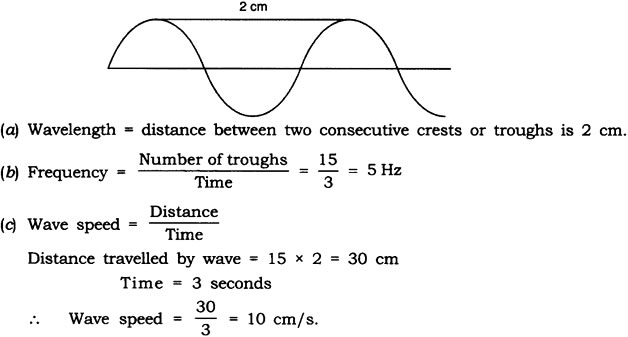Question: A sound produces 13 crests and 15 troughs in 3 seconds. When the second crest is produced the first is 2 cm away from the source? Calculate.
(a) the wavelength (b) the frequency (c) the wave speed.
Answer:
Question: How does the sound produced by a vibrating object in a medium reach your ear?
Answer: Air is the commonest material through which sound propagates. When vibrating objects, like prongs of a tuning fork move forward, they push the molecules of the air in front of them. This in turn compresses the air, thus creating a region of high pressure and high density called compression. This compression in the air travels forward. When the prongs of the tuning fork move backward, they create a region of low pressure in the air, commonly called rarefaction.
This region has low pressure, low density, and more volume. As the tuning fork continues to vibrate, the regions of compression in the air alternate with the regions of rarefaction. These regions alternate at the same place. The energy of vibrating tuning fork travels outward. This energy which reaches the ears, makes the eardrums to vibrate and thus we hear sound
Question: Explain how sound is produced by your school bell.
Answer: Air is the commonest material through which sound propagates. When school bell is rung, it pushes the molecules of the air in front of it. This in turn compresses the air, thus creating a region of high pressure and high density called compression. This compression in the air travels forward. When the bell moves back, it creates a region of low pressure in the air, commonly called rarefaction. This region has low pressure, low density, and more volume. As the bell continues to vibrate, the regions Of compression in the air alternate with the regions of rarefaction. These regions alternate at the same place. The energy of vibrating bell travels outward. This energy which reaches the ears, makes the eardrums to vibrate and thus we hear sound.
Question: Why are sound waves called mechanical waves?
Answer: Some mechanical energy is required to make an object vibrate. Sound energy cannot be produced on its own. The mechanical energy of vibrating object travels through a medium and finally reaches the ear. Therefore, the sound waves are called mechanical waves.
Question: Suppose you and your friend are on the moon. Will you be able to hear any-sound produced by your friend?
Answer: No, I will not be able to hear sound, because moon has no atmosphere. Therefore, no sound waves can travel to your ears and, therefore, no sound is heard.
Question: Which wave property determines (1) loudness, (2) Pitch?
Answer:
- The amplitude of the wave determines the loudness; more the amplitude of a wave, more is the loudness produced.
- The pitch is determined by the frequency of the wave. Higher the frequency of a wave more is its pitch and shriller is the sound.
Question: Guess which sound has a higher pitch; guitar or car horn?
Answer: Car horn has a higher pitch than a guitar, because sound produced by the former is shriller than the latter.
Question: What are wavelength, frequency, time period and amplitude of a sound wave?
Answer: Frequency: The number of compression or rarefaction taken together passing through a point in one second is called frequency.
Time Period: It is the time taken by two consecutive compression or rarefaction to cross a point.
Amplitude: It is the magnitude of maximum displacement of a vibrating particle about its mean position.
 Class Notes NCERT Solutions for CBSE Students
Class Notes NCERT Solutions for CBSE Students




